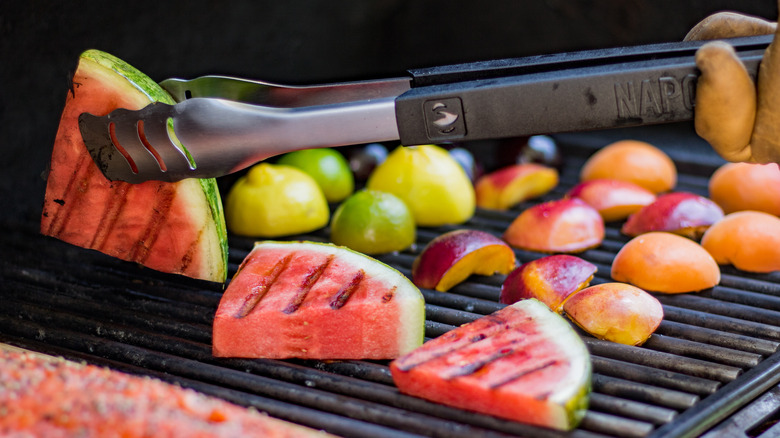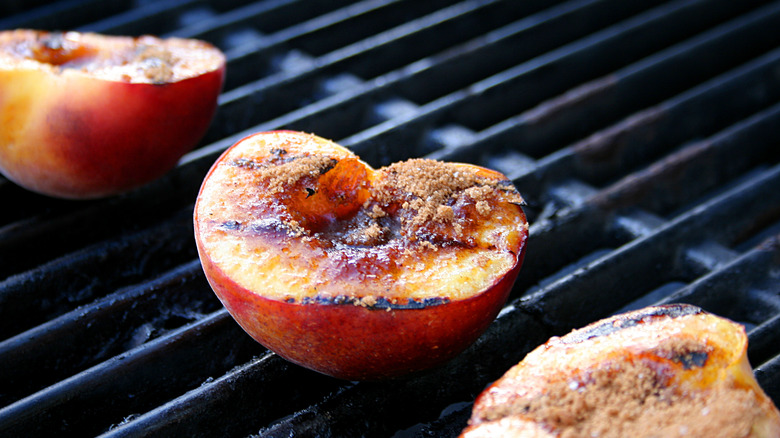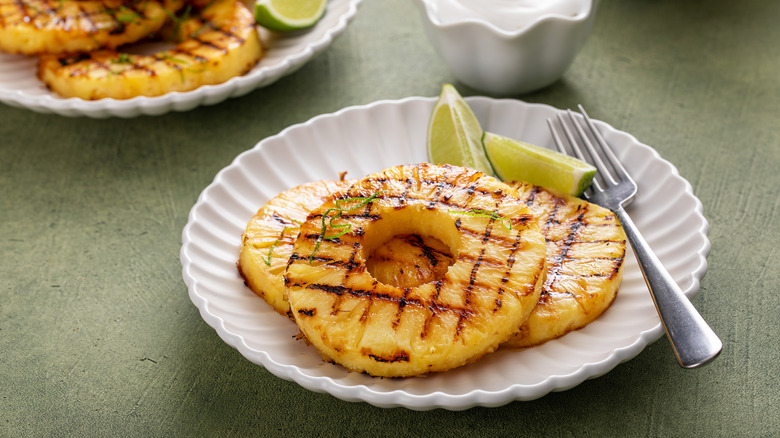When It Comes To Grilling Fruit, Size Matters
Grilled fruit is one of life's greatest pleasures. Not only do the flavors of seasonal fruits intensify when thrown on the barbecue, thanks to their sugars caramelizing, but you'll be able to use them in a ton of fantastic recipes, like a grilled peach and mozzarella flatbread, grilled fruit kebabs with a sweet and spicy glaze, or a grilled plum salad.
When it comes to preparing the fruit, however, there's one note that you should keep in mind: Cutting it into larger chunks or slices is ideal. Not only will the heftier pieces better keep their shape when they come in contact with the intense heat, but making sure your fruit is sturdy enough will also help prevent it from falling between the grates — a potential mess nobody wants to deal with.
If you're grilling smaller fruits — like cherries or strawberries — you can either fold aluminum foil and put them inside to prevent them from getting lost to the flames, or thread them through a skewer if you really want those classic grill marks. Additionally, make sure that your fruit is only moderately ripe, as using overripe fruit, which might be too soft to hold up against the grill, can lead to mushy results.
More tips for grilling fruits
Because fruit is much more delicate than beef or chicken, it's important to treat it as such when grilling. If you have a multi-rack grill, you'll want to use the top rack when working with more fragile pieces of fruit, like cherries or berries. Hitting them with that intense direct heat will do more harm than good.
It's also important to oil the fruit to avoid sticking to the grates. When picking the best oil for grilling, choose oils that have medium or high smoke points (the temperature at which an oil starts burning). These include canola oil, refined sunflower oil, and refined avocado oil (for high smoke points), or olive oil and vegetable oil (for medium smoke points). Avoid using oils with lower smoke points, like extra virgin olive oil and unrefined sunflower or sesame oils.
Caramelizing fruit works best at a slightly lower heat than some meats and other proteins need. Rather than tossing your fruit on the grill next to that steak that requires high heat, you'll have a better result if you wait until the meat is done and then lower the heat to medium — about 350 to 450 degrees Fahrenheit. Then, just lay your oiled fruits cut side down and cook until grill marks form (about three minutes per side for most types).
How to enjoy your grilled fruits
There are tons of great fruits that hold up to the grill, but how do you use them once they're deliciously charred and smoky? Well, that depends on the fruit. Some of the best options include peaches, pineapple, plums, citrus, watermelon, grapes, mangoes, and even bananas. While they can be enjoyed as a snack, taking things up a notch will really have you pulling out the barbecue — or grill pan — more often.
Pineapple is one of the most popular fruits to cook this way. You'll want to make sure you're using the ripest pineapple when grilling, but once it comes off the heat, the possibilities are endless. Grilled pineapple works as a side dish, but it can also be used in a grilled pineapple barbecue chicken. Another option is to throw it on a Hawaiian pulled pork sandwich, or make a grilled pineapple salsa.
Grilled peaches can be used as an appetizer, in a savory meal, or as a dessert — the real MVP of grilled fruits. On a gorgeous charcuterie nestled up next to some burrata? Yes, please. Topped with brown sugar and vanilla ice cream for a summer night treat? Abso-freaking-lutely. Citrus, on the other hand, has more unique uses once grilled. Some can be used in drinks and cocktails, like a charred citrus margarita, but the gorgeous grill marks on slices of lemon or lime are a perfect garnish for virtually any beverage.



